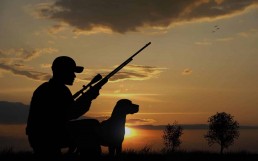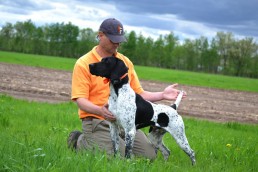When to Follow, When to Lead: The secrets to handling a good hunting dog
SHARE THIS POST
First of the upland seasons will open this month, unleashing an army of hunting dogs onto the landscape. To say that many dogs and their owners will not be on the same page is an understatement nearly as grand as the distance between said dogs and their owners, as the dogs pretty much do what they were born to do (hunt) and the owners yell and blow their whistles to within an inch of an aneurysm. Let’s focus on the bond between dogs and people, in order to help create a winning team, and make for a memorable season.
What does your dog do best?
Assuming it has talent (thanks to its parents), your dog possesses a nose for birds and the desire to hunt them down. Depending upon a lot of factors, especially how tightly you set the screws during obedience training, your dog will also exhibit what they call ‘drive,’ or the urge to get out there in front of you, scenting the ground and sifting the wind, at times seeming frantic to find a bird.
Assuming you have a bond with your dog, created by hanging out together, feeding it, taking it out for walks and training sessions, it should appear to do things ‘for you,’ and ‘with you,’ rather than simply for itself. Years spent hunting together, during which dogs learn to associate the bang of gunfire with birds coming down and the reward of putting birds in their mouths, will greatly enhance a feeling of partnership. Intelligent dogs appear to figure out that you––the person with the stick that makes the loud noise––need to be there when a bird comes up, or there is no loud noise, and no reward of a downed bird.
You see this manifested in a variety of ways, including dogs that, in the heat of the hunt, will spring up out of the grass and twist to look backwards. They are checking to see where you are, making sure that the team is together so the loud noise can cause the bird to fall from the sky.
Talented, intelligent dogs that have been trained with a reasonable approach seem to love what they do for a living. You have to teach them how far away from you is too far, and this can vary whether it’s a flushing or pointing breed.
Beyond that, dogs will amaze you with their ability to develop search images and learn the ways of the birds they hunt most often. As an example, let’s say your dog starts a morning by finding birds in a patch of cattails, or a brush thicket. Don’t be surprised to see the dog notice the next brush thicket and head right for it. All great predators learn to do things like that.
What do you do best?
Here’s what your job is, as the hunter and dog handler.
First and foremost, let the dog do what it was born to do, what it loves to do, hunt for birds. This is so crucial that we mentioned a few ways you can drum the drive and joy out of your dog by the way you train it.
Are you enjoying this post?
You can be among the first to get the latest info on where to go, what to use and how to use it!
Your jobs are…
- To know the boundaries of the property you have permission to hunt;
- To know where roads are, and keep the dog away from them;
- To watch for the possibility your dog is on a deer or porcupine or poisonous snake rather than a bird;
- To keep yourself in position to shoot;
- To remain constantly aware of the location of other hunters;
- To let your dog lead you to birds, except in instances where you think you can improve the odds by directing the dog.
The minute you force your dog off a hot scent “because there would never be a bird in that short grass on top of the hill,” your dog will show you there is a bird, right now, in the short grass on top of the hill. Your job is to let the dog work, and stay in position to shoot.
When a dog scents a bird, it is said to be ‘birdy’ or ‘making game’ or a number of other names for the same thing. There are similarities among dogs, in terms of what they look like when they smell something. But your dog will have its own style, its own look, so your job is also to learn your dog and figure out how you can help it become the best and most successful version of itself.
Pay close attention when your dog looks birdy, and burn into your memory what your dog looks like when it has a bird for sure, and what it looks like when it’s on old scent. Some dogs look birdy all the time, because they are that intense in their work. Some dogs look like they’re mailing it in, when in fact they are on a bird, and it’s for sure.
The trick is to let your dog lead you to birds when that’s the best play, and direct the hunt when that’s the best play. If your dog is false-pointing its way down a fenceline and you see pheasants filling the air a couple hundred yards away, help the dog hurry up. You can look up and see what’s going on around you. Not many dogs make a habit of looking up when they are on hot scent.
If you dog doesn’t have much going, make note of what type of cover they are in. When it gets on bird scent, likewise, make note of what the landscape is like. Patterns can emerge, just like they do in fishing. You can help your dog into high-percentage spots, which helps the dog find more birds.
That’s most of it. It’s both simple and complex, and the key is to follow along at the right times, and temporarily take charge when it will help.
MWO
SHARE THIS POST
Did you enjoy this post?
You can be among the first to get the latest info on where to go, what to use and how to use it!
Mark Strand
MidWest Outdoors editorial director Mark Strand is a graduate of University of Minnesota School of Journalism with a minor in Fisheries & Wildlife Science. He has written for nearly every outdoor magazine over the past 41 years, and has written or co-written 14 books. In addition to writing and photography, Strand produces the MidWest Outdoors Podcast, and contributes to MWO digital properties. He is an outdoor generalist who loves hunting and fishing of all types. In 2018 Strand was elected to the Minnesota Fishing Hall of Fame.



